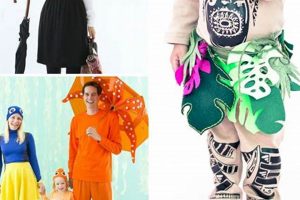Creating a self-fashioned Romani-inspired ensemble involves the independent construction of attire intended to emulate the traditional or romanticized appearance associated with Romani people. This undertaking may encompass the selection of fabrics, patterns, and accessories, along with the hands-on assembly of garments such as layered skirts, blouses with voluminous sleeves, and embellished vests. For example, an individual might choose vibrant, patterned fabrics to sew a tiered skirt and pair it with a loose-fitting, off-the-shoulder blouse, completing the look with coin jewelry and a colorful headscarf.
The practice of crafting such attire allows for personalized expression and creative exploration. It provides an avenue for individuals to interpret and adapt stylistic elements associated with Romani culture, albeit often through a lens of popular imagination. Historically, the romanticized depiction of Romani people has been prevalent in art and literature, influencing the perception and subsequent imitation of their clothing. Engaging in this type of dress-up can foster an appreciation for cultural aesthetics, while also raising awareness of the importance of respectful representation and avoiding harmful stereotypes.
Further discussion will explore the various components that constitute a Romani-inspired look, including fabric choices, accessory selection, and construction techniques. Emphasis will be placed on providing practical guidance for individuals interested in undertaking this project, encouraging mindful engagement with the cultural influences informing the attire.
Crafting a Romani-Inspired Ensemble
The following guidelines offer practical advice for creating Romani-inspired attire. Attention to detail and thoughtful material selection are crucial for a successful outcome.
Tip 1: Fabric Selection: Opt for natural fabrics such as cotton, linen, or rayon. These materials offer breathability and drape well, contributing to the desired flowing silhouette. Consider vibrant colors and patterns, including floral prints, paisleys, or geometric designs. Avoid overly synthetic materials that may appear costumey rather than authentic.
Tip 2: Layering Techniques: Employ layering to achieve a voluminous and textured look. Combine multiple skirts of varying lengths and patterns. Consider adding petticoats or ruffled underskirts to enhance fullness. Layering also provides opportunities to incorporate different colors and textures.
Tip 3: Blouse Construction: A peasant-style blouse with voluminous sleeves is a key element. Consider a gathered neckline that can be worn on or off the shoulders. Elasticized cuffs create a puffed sleeve effect. Lightweight cotton or voile fabrics are ideal for blouse construction.
Tip 4: Vest Embellishment: A vest adds visual interest and structure. Opt for a fitted vest made from velvet, brocade, or faux suede. Embellish with trim, beads, sequins, or embroidery. Consider adding fringe along the hemline for added movement.
Tip 5: Jewelry Incorporation: Incorporate jewelry to enhance the overall aesthetic. Coin necklaces, hoop earrings, and bangles are classic choices. Look for pieces with intricate detailing and antique finishes. Layer multiple necklaces for a bolder statement.
Tip 6: Headscarf Styling: A headscarf completes the ensemble. Choose a silk or cotton scarf in a vibrant color or pattern. Experiment with different tying techniques, such as wrapping the scarf around the head or tying it under the chin. Secure the scarf with bobby pins for added stability.
Tip 7: Footwear Selection: Opt for comfortable and practical footwear. Ankle boots, sandals, or flats are appropriate choices. Avoid high heels or overly modern styles. Consider adding embellishments such as beads or embroidery to the footwear.
Adhering to these tips can contribute to a more refined and aesthetically pleasing result. Careful planning and attention to detail are essential for achieving a successful Romani-inspired look. By focusing on quality materials, thoughtful embellishments, and appropriate layering techniques, it is possible to create an ensemble that evokes the desired aesthetic.
The following section will address the ethical considerations involved in representing Romani culture. Maintaining sensitivity and respect is of utmost importance.
1. Fabric
The connection between fabric and the creation of self-fashioned Romani-inspired attire is fundamental. Fabric selection dictates the visual and tactile character of the finished garment, directly influencing its perceived authenticity and aesthetic appeal. The success of a self-constructed Romani-inspired ensemble hinges significantly on the choice of materials. For instance, using lightweight, flowing fabrics like cotton voile or rayon creates the characteristic draped silhouette often associated with romanticized depictions of Romani dress. Conversely, stiff or synthetic fabrics detract from this aesthetic, resulting in a less convincing and potentially inauthentic representation.
Furthermore, fabric patterns and colors play a critical role. Historically, and within popular representations, vibrant colors, floral prints, paisleys, and geometric designs are commonly associated with Romani-inspired clothing. The selection of these specific patterns directly contributes to the overall visual impression. Using a muted or contemporary pattern would deviate from the established visual cues. Real-world examples include selecting brightly colored cotton prints for tiered skirts, employing textured brocades for vests, and utilizing lightweight scarves in bold patterns for head coverings. Understanding these fabric-related principles allows creators to intentionally evoke the desired aesthetic.
In summary, fabric forms an integral element in replicating the visual style of a self-constructed Romani-inspired attire. Correct fabric type and pattern are critical for a successful replication. Failing to choose correct fabric makes the attire less authentic. By considering the specific fabric characteristics in alignment with established visual motifs, creators increase the fidelity and aesthetic impact of their creations. However, the application of these choices must be balanced with ethical considerations to avoid perpetuating harmful stereotypes or cultural appropriation, reinforcing the need for mindful and informed engagement with Romani cultural representations.
2. Patterns
The utilization of patterns represents a core component in the execution of self-fashioned Romani-inspired attire. Patterns, in this context, serve as templates and guides for the cutting and assembly of fabric pieces into recognizable garments. The choice and application of patterns directly influence the final appearance and perceived authenticity of the crafted ensemble.
- Commercial Patterns Adaption
Existing commercial patterns, originally designed for different
styles, can be adapted to approximate the desired silhouette. For example, a basic skirt pattern might be modified to create a tiered skirt, a common feature in Romani-inspired clothing. Similarly, a peasant blouse pattern can be adjusted to include voluminous sleeves and a gathered neckline. The adaptation of commercial patterns offers a convenient starting point, but requires skill in pattern alteration to achieve an accurate representation. - Self-Drafted Patterns
The creation of patterns from scratch allows for maximum customization and control over the garment’s design. This approach requires a strong understanding of pattern making principles and techniques. Self-drafting enables the creation of unique and complex designs, such as incorporating specific embellishment placements or achieving particular draping effects. However, it demands a higher level of expertise and time investment compared to adapting commercial patterns.
- Historical Pattern References
Although directly replicating historical Romani garments might be challenging due to limited documentation, researching traditional clothing styles from related cultures can provide valuable inspiration. Examining patterns from historical peasant garments across Europe, for instance, can inform the construction of skirts, blouses, and vests. However, it is crucial to avoid direct appropriation and to use these references as inspiration for creating a distinct and respectful interpretation.
- Pattern Complexity and Skill Level
The complexity of the pattern chosen should align with the individual’s sewing skill level. Beginners may opt for simpler patterns with basic construction techniques, such as a straight skirt or a basic blouse. More experienced sewers can tackle complex patterns with advanced techniques, such as intricate pleating, gathering, or draping. Selecting a pattern that matches one’s skill level ensures a more successful and enjoyable sewing experience, while also contributing to a higher-quality finished product.
In conclusion, patterns play a critical role in shaping the visual outcome of creating Romani-inspired attire. Through pattern selection, adaptation, and skilled manipulation, individuals can craft garments that reflect both their personal style and an appreciation for the cultural inspiration. Success hinges not only on technical skill, but also on respect and awareness towards Romani culture, steering away from harmful stereotypes.
3. Accessories
The effective deployment of accessories significantly contributes to the overall aesthetic and perceived authenticity of self-fashioned Romani-inspired attire. Accessories serve as visual cues, signaling a specific cultural or stylistic influence. Their absence or inappropriate selection diminishes the impact of the core garments, leading to a less convincing and potentially diluted representation. For instance, the inclusion of a coin belt, layered necklaces, and a vibrant headscarf immediately evokes imagery associated with romanticized depictions of Romani people. Conversely, omitting these elements, or replacing them with modern jewelry or contemporary headwear, shifts the attire away from its intended inspiration.
Practical significance lies in the ability of accessories to convey detail and nuance, enhancing the narrative presented by the ensemble. Consider the use of fringed shawls or embellished vests; these items add texture and visual interest, contributing to a richer and more layered appearance. The selection of appropriate footwear, such as ankle boots or simple sandals, further grounds the attire in a historical or cultural context. Moreover, accessories provide opportunities for personalization and creative expression while adhering to the established stylistic parameters. One might, for example, customize a headscarf with unique embroidery or select vintage jewelry pieces that reflect a specific era or region.
In summation, accessories function as crucial supporting elements in the creation of self-fashioned Romani-inspired attire. Their deliberate and informed inclusion elevates the overall impact and visual accuracy of the ensemble, reinforcing the desired aesthetic. However, this process necessitates an understanding of the cultural implications and a commitment to responsible representation, avoiding the perpetuation of stereotypes or the appropriation of Romani cultural elements. Thoughtful consideration and respectful application are paramount to successfully leveraging accessories for the intended effect.
4. Construction
The term “construction,” when applied to the creation of self-fashioned Romani-inspired attire, refers to the specific techniques and processes involved in assembling the various garment components. Proficiency in these methods directly impacts the aesthetic outcome and durability of the completed ensemble. The complexity of the construction process also determines the skill level required for a successful undertaking.
- Seam Finishing Techniques
Proper seam finishing is critical for preventing fraying and ensuring the longevity of the garments. Techniques such as serging, zigzag stitching, or bias tape binding are employed to encase raw edges. The choice of seam finish depends on the fabric type and the desired aesthetic. For example, a serged edge provides a clean, professional finish for lightweight fabrics, while bias tape binding adds a decorative element and strengthens the seam. Inappropriately finished seams detract from the overall quality and can lead to premature wear and tear. The selection of a suitable seam finishing technique is key.
- Gathering and Pleating Methods
Gathering and pleating are frequently used to create fullness and volume in skirts and blouses, characteristics often associated with Romani-inspired attire. Various methods exist for achieving these effects, including gathering with a basting stitch, using a gathering foot, or creating pleats by hand. The chosen method influences the distribution of fabric and the overall shape of the garment. Uniformly spaced pleats provide a structured look, while random gathers create a more relaxed and flowing silhouette. Skillful execution of these techniques is essential for achieving the desired aesthetic.
- Embellishment Application Techniques
The application of embellishments, such as beads, sequins, and trim, adds visual interest and texture to the ensemble. Techniques for attaching these elements vary depending on the type of embellishment and the fabric being used. Hand-sewing provides greater control and precision, while machine-sewing offers speed and efficiency. Proper application ensures that the embellishments are securely attached and do not detract from the garment’s drape or comfort. Careful planning and execution are essential for achieving a balanced and aesthetically pleasing result. Failure to properly attach the embellishments could be not only visually unpleasing, but potentially cause bodily harm if embellishments become detached.
- Fitting and Alteration Procedures
Achieving a proper fit is crucial for creating a flattering and comfortable garment. Fitting and alteration procedures involve adjusting the pattern and garment to conform to the wearer’s body shape. This may involve taking in or letting out seams, adjusting the length of sleeves or hems, or reshaping the garment to a
ccommodate specific body contours. A well-fitted garment enhances the overall aesthetic and ensures that the wearer feels confident and comfortable. Neglecting the fitting and alteration process can result in a poorly fitting garment that detracts from the intended aesthetic.
In summary, competent construction techniques form the bedrock upon which a successful self-fashioned Romani-inspired attire is built. Mastering these processes allows for the creation of durable, aesthetically pleasing, and well-fitting garments that effectively evoke the desired stylistic influences. However, emphasis remains on the ethical representation and avoiding the perpetuation of cultural appropriation. By combining technical skill with cultural sensitivity, crafters ensure they are respectful and appropriate.
5. Embellishments
The strategic application of embellishments represents a critical factor in differentiating a self-fashioned garment from a simple piece of clothing, especially within the context of Romani-inspired attire. Embellishments function as visual signifiers, communicating a specific aesthetic and contributing to the perceived authenticity of the ensemble.
- Coin Integration
The incorporation of coins, either real or simulated, has a significant historical precedent in Romani culture and frequently appears in romanticized portrayals. These are typically integrated as part of belts, necklaces, or sewn onto the garment itself. The presence of coins signals prosperity, serves as a form of portable wealth, and enhances the auditory dimension of the attire through the sound of the coins in motion. In authentic contexts, coins often represent a family’s savings, carefully amassed over time.
- Beadwork and Sequins
The application of beadwork and sequins to vests, blouses, and skirts adds visual texture and reflects light, enhancing the garment’s overall vibrancy. Intricate patterns created with beads can depict floral motifs, geometric designs, or abstract compositions. Sequins, particularly when strategically placed, create a shimmering effect that draws attention and elevates the garment’s perceived opulence. The time and skill required for detailed beadwork contribute to the perceived value and artistry of the attire.
- Fringe and Tassels
The addition of fringe and tassels, often constructed from yarn, fabric scraps, or leather, introduces movement and dimension. These are commonly applied to the hem of skirts, shawls, and vests, creating a dynamic visual effect as the wearer moves. The length and density of the fringe can vary depending on the desired aesthetic, ranging from delicate and subtle to bold and dramatic. Fringes may also carry symbolic meaning, representing freedom, travel, or a connection to nature.
- Embroidery and Appliqu
The use of embroidery and appliqu techniques allows for the creation of personalized and intricate designs on the garment’s surface. Embroidery can be used to depict floral motifs, geometric patterns, or narrative scenes, adding a layer of artistic expression. Appliqu involves attaching fabric scraps to the garment to create layered designs. These techniques require skill and patience, but they provide opportunities for customization and the incorporation of unique artistic elements. The colors and materials used in embroidery and appliqu can further enhance the garment’s visual appeal and contribute to its overall cultural significance.
In summary, embellishments act as key components to creating Romani-inspired attire. They contribute to a more complete and successful replication. Embellishments, from coins to embroidery, are critical in transforming a set of clothes into a visual narrative. When creating a do-it-yourself attire, focusing on these points is critical.
6. Silhouette
The silhouette, referring to the overall shape and form of the attire, is a defining characteristic of a self-fashioned Romani-inspired ensemble. The intended silhouette serves as a visual blueprint, guiding the selection of patterns, fabrics, and construction techniques. Achieving the correct silhouette is paramount to conveying the desired aesthetic and distinguishing the attire from other styles. For example, a silhouette characterized by flowing, layered skirts, a fitted bodice, and voluminous sleeves immediately evokes imagery associated with romanticized depictions of Romani dress. Deviating from this established silhouette through the use of modern or structured shapes diminishes the attire’s connection to its intended cultural inspiration.
Specifically, the flowing nature of the skirts and the fullness of the sleeves are crucial elements. The use of lightweight fabrics, multiple layers, and strategic gathering or pleating are instrumental in creating this distinctive shape. The bodice, often achieved through a vest or fitted blouse, provides a counterpoint to the volume of the skirt, creating a balanced and visually appealing form. Experimentation with pattern adjustments and fabric choices allows for variations within this general silhouette, permitting personalization while maintaining the core aesthetic. For instance, the skirt might feature multiple tiers of different lengths, or the sleeves might be embellished with lace or embroidery to add further detail and complexity. The goal is to construct an attire with a specific form.
In conclusion, the silhouette functions as a fundamental element in the creation of a self-fashioned Romani-inspired outfit. A strong silhouette makes the attire more authentic and appealing. Success hinges on a clear understanding of the desired form, meticulous pattern selection, and skillful construction. The achievement of the correct silhouette requires not only technical proficiency but also a conscious awareness of the cultural associations and visual cues inherent in the intended style. By adhering to these principles, creators can effectively convey their intended aesthetic, steering clear of misrepresentation.
7. Cultural Sensitivity
The intersection of “Cultural Sensitivity” and the act of creating “diy gypsy costume” necessitates careful consideration due to the historical and ongoing marginalization of Romani people. The term “gypsy,” itself a misnomer, carries a weight of negative stereotypes and misrepresentations. Therefore, engaging in the creation of attire inspired by Romani culture requires a deliberate approach that prioritizes respect and avoids perpetuating harmful tropes.
- Reclaiming Terminology
The term “gypsy” is often considered derogatory by Romani people due to its association with historical discrimination and inaccurate portrayals. When discussing or creating Romani-inspired attire, employing respectful and accurate language is paramount. This may involve using terms like “Romani-inspired” or “Romani-influenced” rather than “gypsy costume,” acknowledging the cultural origin while avoiding the harmful label. Recognizing and addressing the problematic nature of the term contributes to a more sensitive and informed approach.
- Avoiding Stereotypical Depictions
Romanticized depictions of Romani people often rely on
exaggerated and inaccurate stereotypes, such as associating them with fortune-telling, thievery, or a nomadic lifestyle devoid of societal contribution. When creating attire, it is essential to avoid these harmful tropes. This means moving beyond surface-level representations and researching authentic Romani clothing traditions, considering the diverse styles and regional variations that exist within Romani culture. - Respectful Appropriation vs. Appreciation
The line between cultural appreciation and appropriation can be thin. Cultural appreciation involves learning about and celebrating a culture with respect and understanding, while cultural appropriation involves taking elements from a culture out of context, often for personal gain or without acknowledging their origin. In the context of “diy gypsy costume,” avoiding appropriation means researching the history and significance of Romani clothing traditions, seeking inspiration rather than replication, and acknowledging the source of inspiration when sharing or displaying the attire.
- Engaging with Romani Voices
One of the most effective ways to ensure cultural sensitivity is to engage with Romani voices and perspectives. This may involve reading books, articles, or blogs written by Romani authors, watching documentaries or films that accurately portray Romani life, or seeking out opportunities to connect with Romani communities. By listening to and learning from Romani people, individuals can gain a deeper understanding of their culture and avoid perpetuating harmful stereotypes.
In conclusion, the creation of “diy gypsy costume” demands a proactive and informed approach to cultural sensitivity. By reclaiming terminology, avoiding stereotypes, distinguishing between appreciation and appropriation, and engaging with Romani voices, individuals can create attire that is both aesthetically pleasing and ethically responsible. The goal should be to celebrate Romani culture with respect and understanding, rather than perpetuating harmful misrepresentations.
Frequently Asked Questions
The following addresses common inquiries and considerations regarding the creation of self-fashioned Romani-inspired attire. It aims to provide clarity and guidance on aspects ranging from terminology to construction techniques, while emphasizing ethical and respectful engagement with Romani culture.
Question 1: Is the term “gypsy” appropriate to use when referring to this type of attire?
The term “gypsy” is often considered derogatory and carries a history of negative stereotypes. Employing “Romani-inspired” or “Romani-influenced” is a more respectful and accurate approach, acknowledging the cultural origin while avoiding a potentially offensive label.
Question 2: Where can authentic examples of Romani clothing be found for research and inspiration?
Documenting authentic examples of Romani clothing can be difficult. Resources such as academic articles, museum collections (both physical and online), and reputable cultural organizations may provide valuable insights. Direct engagement with Romani communities and individuals, when possible, offers the most informed perspective.
Question 3: What fabrics are most suitable for creating a Romani-inspired silhouette?
Lightweight, flowing fabrics such as cotton voile, rayon, linen, and silk are well-suited for creating the draped and layered effect associated with Romani-inspired attire. These materials offer breathability, drape well, and contribute to the overall aesthetic.
Question 4: How can stereotypical depictions of Romani people be avoided when designing this attire?
Avoiding stereotypes requires moving beyond surface-level representations and researching authentic Romani cultural traditions. Focus on celebrating the artistry, craftsmanship, and diversity within Romani culture, rather than perpetuating inaccurate and harmful tropes.
Question 5: What are some essential accessories for completing a Romani-inspired ensemble?
Key accessories often include coin belts, layered necklaces, vibrant headscarves, and embellished vests. The selection and styling of accessories should complement the overall aesthetic and contribute to the garment’s visual narrative.
Question 6: How can cultural appropriation be avoided when creating Romani-inspired attire?
Avoiding appropriation involves engaging with Romani culture respectfully, acknowledging the source of inspiration, and avoiding the commercialization or misrepresentation of cultural elements. Seeking guidance from Romani individuals and communities is essential.
In summary, the creation of self-fashioned Romani-inspired attire necessitates a balance between aesthetic expression and cultural responsibility. A mindful and informed approach, grounded in respect and understanding, is paramount.
The subsequent section will address ethical considerations when participating in self-fashioned cultural attire practices.
Conclusion
This article has explored the multifaceted aspects of self-constructed Romani-inspired attire, frequently identified by the keyword phrase. Emphasis has been placed on materials, techniques, silhouette, and accessory considerations. The exploration has underscored the critical importance of accurate representation and the avoidance of perpetuating harmful stereotypes commonly associated with Romani people. Ethical engagement with cultural elements has been presented as non-negotiable.
The practice of creating attire referencing another culture demands reflection and responsibility. Moving forward, individuals should prioritize informed creativity, ensuring that any engagement with Romani-inspired aesthetics proceeds with deep respect for the source and a commitment to dismantling inaccurate or damaging representations. The future of such endeavors lies in celebrating diversity thoughtfully, not appropriating it carelessly.







